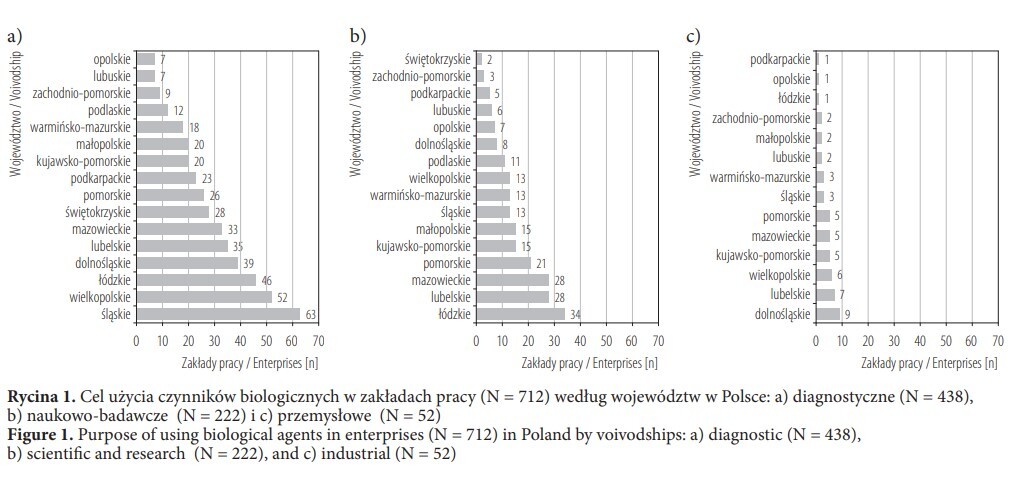Online first
Current issue
Archive
Most cited in 2024
About the Journal
Editorial Office
Editorial Board
Copyright and self-archiving policy
Information clause on the processing of personal data
Declaration of accessibility
Instructions for Authors
Instructions for Reviewers
Contact
Reviewers
2024
2023
2022
2020
2021
2019
2018
2017
2016
2015
2014
2013
Editing and translations
ORIGINAL PAPER
Intentional use of harmful biological agents in work processes in Poland based on the National Register of Biological Agents
1
Instytut Medycyny Pracy im. prof. J. Nofera / Nofer Institute of Occupational Medicine, Łódź, Poland (Zakład Bezpieczeństwa Chemicznego, Pracownia Bezpieczeństwa Biologicznego / Department of Chemical Safety, Biological Safety Unit)
Online publication date: 2023-12-23
Corresponding author
Anna Kozajda
Instytut Medycyny Pracy im. prof. J. Nofera, Zakład Bezpieczeństwa Chemicznego, Pracownia Bezpieczeństwa Biologicznego, ul. św. Teresy 8, 91-348 Łódź
Instytut Medycyny Pracy im. prof. J. Nofera, Zakład Bezpieczeństwa Chemicznego, Pracownia Bezpieczeństwa Biologicznego, ul. św. Teresy 8, 91-348 Łódź
Med Pr Work Health Saf. 2023;74(6):501-11
KEYWORDS
harmful biological agentsintentionally use of biological agentsbiohazarddeliberate activities with biological agentsoccupational exposure to biological agentsbiorisk management
TOPICS
ABSTRACT
Background: The work presents the intentional use of harmful biological agents based on National Register of Biological Agents (Krajowego Rejestru Czynników Biologicznych – KRCB) collected by June 2023. Material and Methods: The KRCB is a central database gathering notifications of the intentional use of biological agents in risk groups 2–4 in the workplace in accordance with the regulation of the Minister of Health of December 11, 2020 amending the regulation regarding biological agents. Results: with the regulation of the Minister of Health of December 11, 2020 amending the regulation regarding biological agents. Results: Notifications were sent by 712 enterprises for: diagnostic – 62%, research – 31% and industrial purposes – 7%. Notifications were most often sent by hospital and non-hospital clinical and diagnostic laboratories (33% each group) and higher education and research units – 16%. In total, 7352 workers (88% women, 12% men) were exposed to biological agents intentionally used at work. Biological agents from 2 and 3 group risk were used by 98% and 16% enterprises, respectively. The most frequently were used bacteria Escherichia coli (with the exception of non-pathogenic strains) – 5972 (81%) exposed workers, Staphylococcus aureus – respectively 5760 (78%) and Pseudomonas aeruginosa – 5155 (70%). Among the total workers, nearly 25% were exposed to at least 1 biological agent
carcinogenic to humans, including viruses (hepatitis B virus [HBV] – 1800 workers, 24%; hepatitis C virus [HCV] – respectively,
1767, 24%; human immunodeficiency virus-1 [HIV-1] – 1557, 21%; human gammaherpesvirus type 4 (Epstein-Barr virus) – 199,
3%; Papillomaviridae – 52, <1%; human gammaherpesvirus type 8 [HHV-8] – 16, <1%; human T-lymphotropic virus type 1 [HTLV-
1] – 38, <1%; bacteria Helicobacter pylori – 299, 4%; parasites Schistosoma haematobium – 9, <1%). Conclusions: Intentionally used
biological agents most often pose a threat to workers of hospital and non-hospital clinical and diagnostic laboratories, but a higher
health risk concerns workers of and higher education and research units. Med Pr Work Health Saf. 2023;74(6):501–11.
Share
RELATED ARTICLE
We process personal data collected when visiting the website. The function of obtaining information about users and their behavior is carried out by voluntarily entered information in forms and saving cookies in end devices. Data, including cookies, are used to provide services, improve the user experience and to analyze the traffic in accordance with the Privacy policy. Data are also collected and processed by Google Analytics tool (more).
You can change cookies settings in your browser. Restricted use of cookies in the browser configuration may affect some functionalities of the website.
You can change cookies settings in your browser. Restricted use of cookies in the browser configuration may affect some functionalities of the website.






